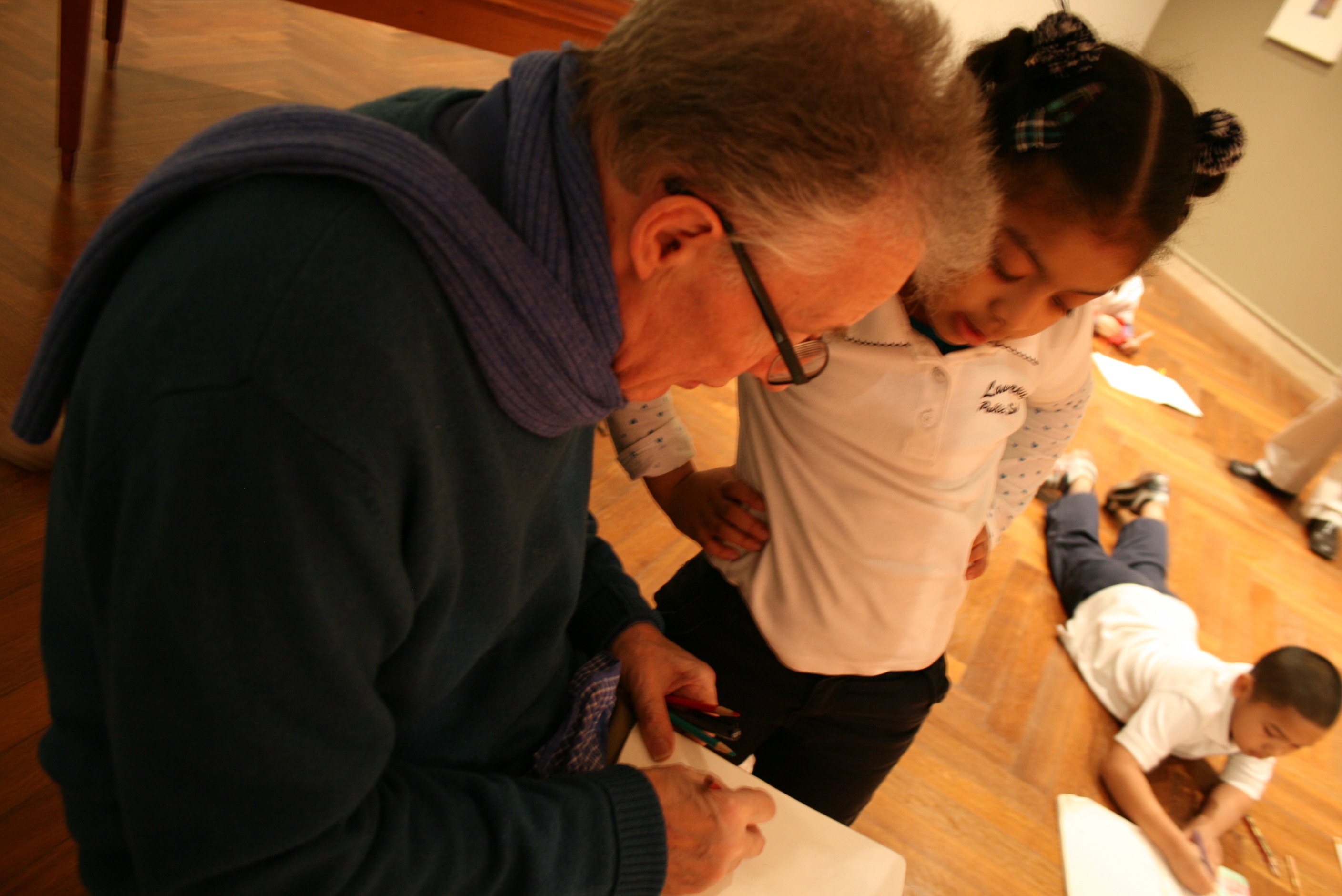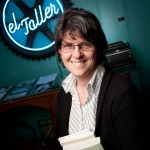The Pedagogy of the Imagination: Professor Michael Armstrong
1September 6, 2013 by Tom McKenna
 —by Tom McKenna
BLTN Director of Communications, BLSE 1996
—by Tom McKenna
BLTN Director of Communications, BLSE 1996
In a recent Middlebury Magazine clip featuring Bread Loaf courses that excited students, it’s hard to miss the sparkle in people’s eyes as they attest to loving Professor Michael Armstrong’s classes (“The Fantastic and the Marvelous: Exploring the Fictional Worlds of Italo Calvino” and “Describing the Imagination”). As a former—and lifelong—student of Michael, I know the popularity of his classes comes from his contagious curiosity, keen memory, encyclopedic philosophical knowledge, his great sense of humor, and his abiding faith in the creative power of young people. In his 2010 book, What Children Know, Professor Armstrong applies an Italo Calvino phrase, “the pedagogy of the imagination,” to describe a teaching stance that he has shared with members of the Bread Loaf Teacher Network, as he has himself refined it over years of teaching at Bread Loaf.
From the Mountain to the Classroom
This summer, I asked Mary Guerrero, an elementary teacher in Lawrence, Massachusetts, to describe the impact on her classroom of Michael’s classroom residencies there. I also asked Lou Bernieri, director of Andover Bread Loaf (see related ABL pieces in this issue) to give his take on how Michael’s philosophy and pedagogy have influenced the work of ABL. Finally, I spent an hour with Michael himself, who elaborated on many of the ideas central to his teaching, his writing, and his influence on the Bread Loaf Teacher Network. They give their perspectives below.
Mary Guerrero
Oliver Partnership School and El Taller Bookstore and Cafe, Lawrence, MA BLSE 2005Over the years, when I have had the opportunity to share my classroom with Michael Armstrong, we often did something similar to Michael’s method in a course he teaches at Bread Loaf called “Describing the Imagination.” The students and I, along with Michael, would sit in a circle and talk about the qualities in a piece of writing that a student had offered to share. In this model of noticing, we learned that each person’s perspective increased our awareness and understanding of the work and, in turn, our group’s ability to create individual and collective meanings from a piece of writing. No thought was insignificant because, often, with further reflection we understood more. Students then were able to build ideas on the participation of other students, changing the dynamics of the classroom. We looked closely at the student work and took turns so each of us had an opportunity to state what we saw in the work.
One day a boy named Christian added that he noticed that the student writer’s name was on the work. At first, this comment didn’t seem to add anything to the conversation. But Michael became intrigued with the “signed” piece of writing. The essay, Michael suggested, was about identity and maybe we had missed something Christian had noticed. We looked back at some of the other work we had discussed and realized that it wasn’t a given to find the writer’s name at the top. Also, in the essay under discussion, the author not only signed her name to the piece but repeated her own name in the work as it discussed her favorite doll. Michael decided that he needed to know more. He took out his black journal and reflected on Christian’s participation, and the next day he interviewed Christian. As the two discussed the comment from the previous day, they constructed a collaborative and mutual understanding about the writer and her work. This substantive inquiry was the foundation on which Michael and Christian built a shared process for teaching and learning. After these discussions—among the entire class and in one-on-one interviews with Michael—students were noticeably more motivated to write and to think deeply and analytically about their own work and the work of their peers. They became experts on their work. With this inquiry-based seeking of knowledge, the teacher and his or her students become co-creators of the learning environment. And in the long run, students develop the capacity to trust their own learning and thinking.
Lou Bernieri
Director, Andover Bread Loaf
Michael’s work with us on “educating the imagination” focuses on young children, and shares some educational principles with those of the Reggio Emilia approach. But we have used it for all age levels. We see that educating the imagination requires students to tackle issues of identity and empowerment, and it can change the academic and personal trajectory of youth. If you revisit the video on our writing leaders and hear what Noelia Bare has to say about the critical importance of the Bread Loaf creative writing programs to her development from a Spanish-speaking child to a highly successful adult, you’ll see one testimony about this.
We’re driven very much by social justice. Educating the imagination, we believe, is a political act, something that inevitably leads people of all ages to consider social justice issues from new perspectives.
While there is so much to say about the example Michael provides as a teacher (and learner), his collaborative assessment procedure (described above by Mary Guerrero) may be the most important tool we have to reveal the power and sacredness of a child’s—or anyone’s—imagination. As he and Dixie Goswami always repeat, the process of teachers looking carefully at student writing is a transformative act.
Michael Armstrong’s principles of learning are reflected in our regular family literacy nights and in more than 100 elementary school workshops we’ve organized for teachers and students. We’ve learned that these events are not about a brilliant artist or teacher presenting a brilliant lesson. Rather, they are about giving participants a simple invitation to write whatever piques their imaginations. We get everyone writing quickly and unselfconsciously and then get out of the way. I begin all of such writing workshops by saying very loudly, “You can’t make a mistake. Whatever you write is great (as long as it’s not offensive.) This is all about getting what’s in your imagination on the page.” (I always say, “You can write in any language,” which is another way of saying, “It’s purely about your imagination.”
Describing “Describing the Imagination”
In the opening of our interview, I asked Michael to review the premise of the class, “Describing the Imagination.” After describing the procedure—in which participants take turns revealing what they notice in an original work by a student (with the teacher withholding comment until all have had a turn) and in which the interpretive process includes collective meaning-making informed by a class journal—Michael spoke to the shifts that he has witnessed course participants make in their understanding of their own students’ writing. Specifically, he related how a teacher’s sustained inquiry into a student’s work, through discussion, note-taking, and journal reflection, begins to change the teacher’s perspective on the piece of work: it is no longer a faulty imitation of an adult piece of writing, “inadequate with faults of grammar, punctuation and spelling,” but rather a revealing example, perhaps even an exemplar, of the full extent of a student’s artistic aspiration and achievement. Find Professor Armstrong’s comments at this link:
The Pedagogy of the Imagination: Implications for Policy
In the second phase of the interview, I asked Michael to comment on his theoretical stance for teaching and assessment in the light of the current environment surrounding educational policy. At the link below, Michael describes what he calls “The Pedagogy of the Imagination.” Drawing on the writings of Italo Calvino and John Dewey, Michael posits a distinction between “technique” and creativity, and he critiques the contemporary obsessions with the techniques of “formal correctness” and “measurement” at the expense of understanding a student’s creative achievements—in both Great Britain and the United States.
What Teachers Need
Finally, I asked Michael about the kind of professional development or training that teachers employing an interpretive stance might need. Based on decades of teaching and scholarship, as well as his leadership of a primary school in Great Britain, Professor Armstrong makes the case that teachers need time and opportunity to deepen their own interpretive and inquiry skills.
Our Invisible Cities: A NYC and Vermont Student Exchange for 2013-2014
Holly Spinelli
This summer at Bread Loaf I enrolled in Michael Armstrong’s class on Italo Calvino’s literature. As we read Calvino’s Invisible Cities, the class discussions began to focus on the meaning behind Calvino’s initial descriptions of the beautiful, mystical, and cryptic cities that exist on the periphery of reality, usually invisible to the naked eye. This focus made me think about the city where I work, New York City, and how for all of its beauty, fame, and infamy, so much of it goes unnoticed and remains “invisible” to its residents and visitors. Professor Armstrong’s class inspired me to consider how to use these ideas with my own students in a very hands-on, creative, and meaningful way, in a unit of study with my advisory seminar students (ages 16-21) called “Our Invisible Cities.”
While at Bread Loaf in Vermont, I brought this idea to a BLTN meeting, and Colleen Kiley, a public high school teacher in Bristol, Vermont, was eager to help make this project a student exchange between her students and mine. In this unit, my students will be asked to inform their peer audience in Vermont about the unsung beauty and cultural richness that they know and love in their own neighborhoods in all boroughs of New York City. To do this, they will create a series of digital videos or photographs, or they will be invited to use another creative visual medium.
Colleen and I are excited to offer our students the opportunity to do research in and about their own towns and cities and to proudly share their findings with one another. Our students tend to become locked into specific stereotypes based on their rural and urban surroundings, and Colleen and I hope that this project will showcase our students’ creativity and offer them a genuine opportunity to take pride in their respective environments by teaching and learning with a group of peers from a vastly different area in the country. We hope this exchange will allow them to discover more about themselves by studying the history and culture of their local areas while celebrating the beauty and uniqueness of their own experiences.
Professor Armstrong’s latest book, What Children Know, is a available for purchase on Lulu.
Category Faculty Notes, Fall 2013, Issue | Tags:

When I took Michael Armstrong’s narrative class in 1993 it completely
changed the way that I engaged with my students when we talked about
their writing. Instead of focusing on “improving” the writing through
revision, as I’d been trained to do through my experience with NWP, my
first goal was to understand the student’s writing and to look at as a
piece of art first. I ended up restructuring my classroom and the
writing workshops so that there was more time for substantive
conversations about the meaning of the writing that my 8th grade
students were producing. This course was one of my at Bread Loaf where
I left with my head spinning as I returned to my classroom in the fall,
with many of my assumptions about teaching and learning evaporated. I
will also be very grateful for the important scholarly work that Micheal
has done as well as the graceful and passionate way that he nudges
teachers along in their understanding of pedagogy.